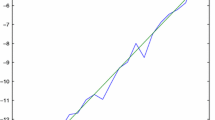Abstract
We consider a class of discrete operators introduced by O. Chodosh, acting on infinite sequences and mimicking standard properties of pseudo-differential operators. By using a new approach, we extend this class to finite or periodic sequences, allowing a general representation of discrete pseudo-differential operators obtained by finite differences approximations and easily transferred to time discretizations. In particular we can define the notion of order and regularity, and we recover the fundamental property, well known in pseudo-differential calculus, that the commutator of two discrete operators gains one order of regularity. As examples of practical applications, we revisit standard error estimates for the convergence of splitting methods, obtaining in some Hamiltonian cases no loss of derivative in the error estimates, in particular for discretizations of general waves and/or water-waves equations. Moreover, we give an example of preconditioner constructions inspired by normal form analysis to deal with the similar question for more general cases.



Similar content being viewed by others
Notes
Here \(\langle x\rangle ^2=1+|x|^2\).
Using typically the fact that the unbounded part can be diagonalized explicitly in Fourier to define mild-solutions, an example is given below.
Working with arbitrary integers is of course possible, by changing the structure of \(G_K\) according to the parity of K, see [12]
It is also easy to prove the stability estimates (4.3)
References
S. Agmon, A. Douglis and L. Nirenberg , Estimates near the boundary for solutions of elliptic partial differential equations satisfying general boundary conditions I, Comm. Pure Appl. Math. 12, 623–727, (1959)
P. Bader, A. Iserles, K. Kropielnicka and P. Singh, Effective approximation for the linear time-dependent Schrödinger equation, Found. Comp. Maths 14 (2014), 689–720.
D. Bambusi, B. Grébert, A. Maspero and D. Robert. Growth of Sobolev norms for abstract linear Schrödinger equations. Journal of the European Mathematical Society 23 (2), 557-583, (2020).
J. Bernier, E. Faou and B. Grébert, Long time behavior of the solutions of NLW on the d-dimensional torus Forum of Math. Sigma (2020) 26 pages.
S. Blanes, F. Casas, A. Murua, Splitting and composition methods in the numerical integration of differential equations, Bol. Soc. Esp. Mat. Apl. 45, pp. 89–145 (2008).
A. Bressan, Hyperbolic system of conservation laws. The one-dimensional Cauchy problem, Oxford lecture series in mathematics and its applications 20, 2000.
F. Casas, N. Crouseilles, E. Faou and M. Mehrenberger, High-order Hamiltonian splitting for Vlasov-Poisson equations. Numer. Math. 135, 769–801, (2017).
W. Craig, D. Lannes, C. Sulem. Water waves over a rough bottom in the shallow water regime. Ann. I. H. Poincaré - AN 29 (2012) 233–259.
O. Chodosh, Infinite matrix representations of classes of pseudo-differential operators. Undergraduate thesis (2010).
O. Chodosh, Infinite matrix representations of isotropic pseudo-differential operators, Methods Appl. Anal., vol. 18, no. 4, 351–372, (2011)
R. Di Perna and P. L. Lions, Ordinary differential equations, transport theory and Sobolev spaces, Invent. Math. 98, 511–547, (1989).
E. Faou, Geometric Numerical Integration and Schrödinger Equations. European Math. Soc. 2012
E. Faou and T. Jézéquel, Resonant time steps and instabilities in the numerical integration of Schrödinger equations. Differential and Integral Equations 28, 221–238, (2015).
J. Ginibre and G. Velo. Scattering theory in the energy space for a class of nonlinear Schrödinger equations. J. Math. Pures Appl. , 64(4):363–401, (1985)
E. Hairer, C. Lubich, and G. Wanner, Geometric Numerical Integration. Structure-Preserving Algorithms for Ordinary Differential Equations, Springer, second edition, 2006.
L. Hörmander, The Analysis of Linear Partial Differential Operators III: Pseudo-Differential Operators. Classics in Mathematics. Springer, 1987.
T. Jahnke and Ch. Lubich. Error bounds for exponential operator splittings. BIT, vol. 40, No 4, pp 735-744 (2000)
D. Lannes, The Water Waves Problem, Mathematical Analysis and Asymptotics. Mathematical Surveys and Monographs, Vol. 188. American Mathematical Society, 2013.
C. Lubich, From quantum to classical molecular dynamics: reduced models and numerical analysis. European Math. Soc., 2008.
A. Ostermann, F. Rousset, K. Schratz. Error estimates of a Fourier integrator for the cubic Schrödinger equation at low regularity. Found. Comput. Math. 21:725–765 (2021)
M. E. Taylor, pseudo-differential Operators, Princeton Univ. Press (1981).
Acknowledgements
During the preparation of this work the two authors benefited from the support of the Centre Henri Lebesgue ANR-11-LABX- 0020-01 and B.G. was supported by ANR -15-CE40-0001-02 “BEKAM” of the Agence Nationale de la Recherche. Furthermore B.G. thanks INRIA and particularly the MINGuS project for hosting him for a semester.
Author information
Authors and Affiliations
Corresponding author
Additional information
Communicated by Arieh Iserles.
Publisher's Note
Springer Nature remains neutral with regard to jurisdictional claims in published maps and institutional affiliations.
A Young Inequality for Convolution
A Young Inequality for Convolution
Let \(x = (x_n)_{n \in \mathbb {Z}^d}\) and \(y = (y_n)_{n \in \mathbb {Z}^d}\) two sequences. We define \(z = x * y = (z_n)_{n \in \mathbb {Z}^d}\) the sequence
We also define for \(p \ge 1\),
And we recall the following Hölder inequality: for two sequences x, y
which is itself a consequence of the Young inequality for product: \(\forall a,b\ge 0\) we have \(ab \le \frac{a^p}{p} + \frac{b^q}{q}\). This Hölder inequality is easily generalized by induction to
for any sequences \(x^{(i)}\), \(i = 1, \ldots , N\) with \(N \in \mathbb {N}\).
Lemma A.1
For two sequences x and y indexed by \(\mathbb {Z}^d\), we have
Proof
Let us denote \(z = x * y\), we have
where we used the generalized trilinear Hölder inequality for the decomposition
Then we obtain
\(\square \)
Rights and permissions
Springer Nature or its licensor (e.g. a society or other partner) holds exclusive rights to this article under a publishing agreement with the author(s) or other rightsholder(s); author self-archiving of the accepted manuscript version of this article is solely governed by the terms of such publishing agreement and applicable law.
About this article
Cite this article
Faou, E., Grébert, B. Discrete Pseudo-differential Operators and Applications to Numerical Schemes. Found Comput Math (2024). https://doi.org/10.1007/s10208-024-09645-y
Received:
Revised:
Accepted:
Published:
DOI: https://doi.org/10.1007/s10208-024-09645-y
Keywords
- Pseudo-differential operators
- Numerical methods for discrete and fast Fourier transforms
- Finite difference methods
- Splitting methods.



